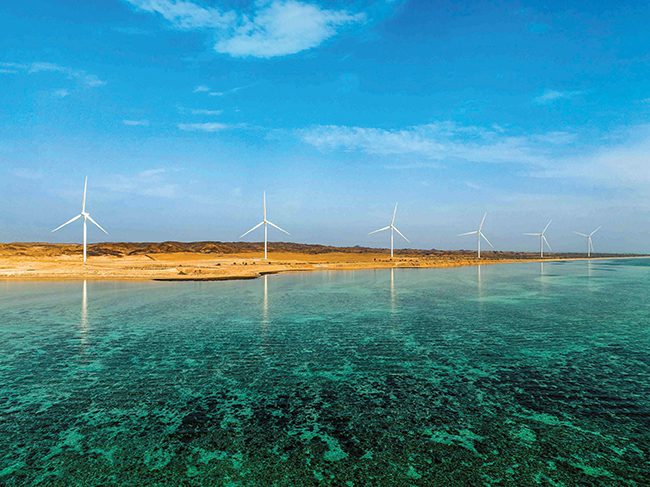UAE Launches 104-MW Wind Project Despite Low Winds
A landmark utility-scale wind project is now operational in the United Arab Emirates (UAE), despite previous concerns that large-scale wind energy is not viable owing to the region’s low wind speeds.
|
|
|
Masdar in October 2023 inaugurated a 27-MW wind farm located on Delma Island in Abu Dhabi, one of four wind farms that make up the United Arab Emirate’s first utility-scale wind project. Courtesy: Masdar |
Abu Dhabi Energy Co.—better known as Masdar—on Oct. 5 inaugurated a 103.5-MW project that spans four locations. Three are in Abu Dhabi (Figure 4): Sir Bani Yas Island (45 MW), Delma Island (27 MW), and Al Sila (27 MW). A fourth 4.5-MW installation was completed in Al Halah, Fujairah. Emirates Water and Electricity Company (EWEC) will purchase the power from the Sir Bani Yas Island, Al Sila, and Delma Island projects, via a power purchase agreement.
The project was enabled by “innovations within climate technology and UAE-led expertise made wind power possible,” Masdar said. “Bigger turbine sizes, lower hardware prices, and the discovery of a unique weather phenomenon that generated high winds at night made this project scalable and economically viable,” it explained. “As wind power is strongest at night in the UAE, this complements the country’s existing solar power generation, further diversifying the nations renewable energy mix,” it said.
Masdar will now work with global technology leaders and turbine manufacturers to “commercialize and further” utility-scale low-wind-speed projects. “The project is creating a foundation of critical scientific wind data, which will form the basis of the UAE’s next phase of development,” it noted.
The development marks notable progress for the UAE, a Gulf Cooperation Council (GCC) region that has historically relied heavily on fossil fuels for power and income. While total electricity capacity has grown by almost 10 GW since 2012, reaching 43.5 GW in 2021, about 44% of that growth was derived from fossil fuels. However, since the region embarked on an effort to build out its renewables with the launch of the 100-MW Shams project—the first concentrated solar power plant to be developed in the Middle East—a decade ago, it has substantially expanded its clean energy portfolio with new solar PV and waste-to-energy-plants. One example is the 1.2-GW Sweihan solar park in Abu Dhabi.
The UAE has also introduced nuclear power. Three of four planned nuclear units at the Barakah power plant, the UAE’s first commercial nuclear plant, are now currently operational, and once completed, the 5.6-GW project in the Al Dhafra region, is expected to meet up to 25% of the UAE’s electricity demand.
Earlier this year, notably, the seven-emirate union adopted a National Energy Strategy that set out a specific target energy distribution that will meet its economic needs and environmental aspirations. The strategy calls for 44% clean energy, 38% natural gas, 12% clean coal, and 6% nuclear energy by 2050. It will require procuring 14 GW of renewable capacity, up from about 2.4 GW in 2020.
Along with wind power, the UAE has explored hydropower, despite its limited natural water bodies. The Dubai Electricity and Water Authority (DEWA) is currently building the 250-MW (1,360-MWh) Hatta pumped storage hydropower plant. When that project is commissioned in 2024, it will be the first hydropower plant of its kind on the Arabian Peninsula.
The region also plans to expand its fossil fleet, however. The 2.4-GW Hassyan power plant—under construction in Saih Shuaib, Dubai—is slated to begin operating this year. While originally designed to operate on coal, the project was switched to operate on natural gas in February. The plant will feature four 600-MW ultrasupercritical (USC) boilers, steam turbines, and generators. Specifications also call for the plant to be carbon capture ready.
—Sonal Patel is a senior associate editor for POWER.
